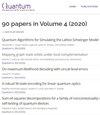Operational Quantum Reference Frame Transformations
IF 5.1
2区 物理与天体物理
Q1 PHYSICS, MULTIDISCIPLINARY
引用次数: 0
Abstract
Quantum reference frames are needed in quantum theory for much the same reasons that reference frames are in classical theories: to manifest invariance in line with fundamental relativity principles and to provide a basis for the definition of observable quantities. Though around since the 1960s, and used in a wide range of applications, only recently has the means for transforming descriptions between different quantum reference frames been tackled in detail. In this work, we provide a general, operationally motivated framework for quantum reference frames and their transformations, holding for locally compact groups. The work is built around the notion of operational equivalence, in which quantum states that cannot be physically distinguished are identified. For example, we describe the collection of relative observables as a subspace of the algebra of invariants on the composite of system and frame, and from here the set of relative states is constructed through the identification of states which cannot be distinguished by relative observables. Through the notion of framed observables – the formation of joint observables of system and frame – of which the relative observables can be understood as examples, quantum reference frame transformations are then maps between equivalence classes of relative states which respect the framing. We give an explicit realisation in the setting that the initial frame admits a highly localized state with respect to the frame observable. The transformations are invertible exactly when the final frame also has such a localizability property. The procedure we present is in operational agreement with other recent inequivalent constructions on the domain of common applicability, but extends them in a number of ways, and weakens claims of entanglement generation through frame changes.求助全文
约1分钟内获得全文
求助全文
来源期刊

Quantum
Physics and Astronomy-Physics and Astronomy (miscellaneous)
CiteScore
9.20
自引率
10.90%
发文量
241
审稿时长
16 weeks
期刊介绍:
Quantum is an open-access peer-reviewed journal for quantum science and related fields. Quantum is non-profit and community-run: an effort by researchers and for researchers to make science more open and publishing more transparent and efficient.
 求助内容:
求助内容: 应助结果提醒方式:
应助结果提醒方式:


